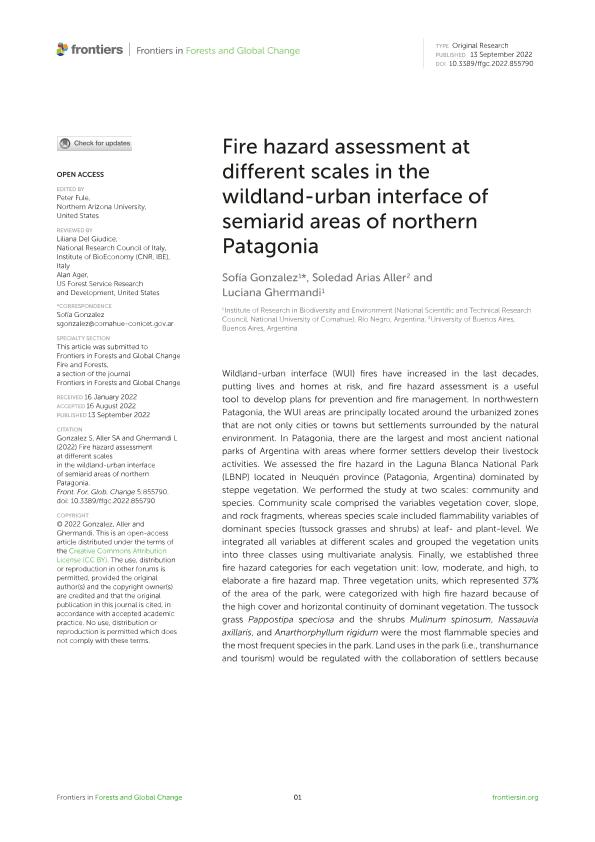Mostrar el registro sencillo del ítem
dc.contributor.author
Gonzalez, Sofia Laura

dc.contributor.author
Arias Aller, Soledad
dc.contributor.author
Ghermandi, Luciana

dc.date.available
2023-07-05T18:20:32Z
dc.date.issued
2022-09
dc.identifier.citation
Gonzalez, Sofia Laura; Arias Aller, Soledad; Ghermandi, Luciana; Fire hazard assessment at different scales in the wildland-urban interface of semiarid areas of northern Patagonia; Frontiers Media; Frontiers in Forests and Global Change; 5; 9-2022; 1-14
dc.identifier.uri
http://hdl.handle.net/11336/202514
dc.description.abstract
Wildland-urban interface (WUI) fires have increased in the last decades, putting lives and homes at risk, and fire hazard assessment is a useful tool to develop plans for prevention and fire management. In northwestern Patagonia, the WUI areas are principally located around the urbanized zones that are not only cities or towns but settlements surrounded by the natural environment. In Patagonia, there are the largest and most ancient national parks of Argentina with areas where former settlers develop their livestock activities. We assessed the fire hazard in the Laguna Blanca National Park (LBNP) located in Neuquén province (Patagonia, Argentina) dominated by steppe vegetation. We performed the study at two scales: community and species. Community scale comprised the variables vegetation cover, slope, and rock fragments, whereas species scale included flammability variables of dominant species (tussock grasses and shrubs) at leaf- and plant-level. We integrated all variables at different scales and grouped the vegetation units into three classes using multivariate analysis. Finally, we established three fire hazard categories for each vegetation unit: low, moderate, and high, to elaborate a fire hazard map. Three vegetation units, which represented 37% of the area of the park, were categorized with high fire hazard because of the high cover and horizontal continuity of dominant vegetation. The tussock grass Pappostipa speciosa and the shrubs Mulinum spinosum, Nassauvia axillaris, and Anarthorphyllum rigidum were the most flammable species and the most frequent species in the park. Land uses in the park (i.e., transhumance and tourism) would be regulated with the collaboration of settlers because increase the vulnerability to wildfires. Our fire hazard map constitutes a valuable tool because it identified the most vulnerable WUI in the LBNP. This study emphasizes the need to include flammability and fuel load studies in fire management plans to better protect human lives and natural resources in protected areas.
dc.format
application/pdf
dc.language.iso
eng
dc.publisher
Frontiers Media

dc.rights
info:eu-repo/semantics/openAccess
dc.rights.uri
https://creativecommons.org/licenses/by/2.5/ar/
dc.subject
FIRE HAZARD MAP
dc.subject
FLAMMABLE SPECIES
dc.subject
MULTIVARIATE ANALYSIS
dc.subject
PROTECTED AREAS
dc.subject
STEPPE
dc.subject
WILDLAND URBAN INTERFACE FIRES
dc.subject.classification
Ecología

dc.subject.classification
Ciencias Biológicas

dc.subject.classification
CIENCIAS NATURALES Y EXACTAS

dc.subject.classification
Ciencias Medioambientales

dc.subject.classification
Ciencias de la Tierra y relacionadas con el Medio Ambiente

dc.subject.classification
CIENCIAS NATURALES Y EXACTAS

dc.title
Fire hazard assessment at different scales in the wildland-urban interface of semiarid areas of northern Patagonia
dc.type
info:eu-repo/semantics/article
dc.type
info:ar-repo/semantics/artículo
dc.type
info:eu-repo/semantics/publishedVersion
dc.date.updated
2023-06-29T10:09:05Z
dc.identifier.eissn
2624-893X
dc.journal.volume
5
dc.journal.pagination
1-14
dc.journal.pais
Suiza

dc.description.fil
Fil: Gonzalez, Sofia Laura. Consejo Nacional de Investigaciones Científicas y Técnicas. Centro Científico Tecnológico Conicet - Patagonia Norte. Instituto de Investigaciones en Biodiversidad y Medioambiente. Universidad Nacional del Comahue. Centro Regional Universidad Bariloche. Instituto de Investigaciones en Biodiversidad y Medioambiente; Argentina
dc.description.fil
Fil: Arias Aller, Soledad. Universidad de Buenos Aires. Facultad de Ciencias Exactas y Naturales; Argentina
dc.description.fil
Fil: Ghermandi, Luciana. Consejo Nacional de Investigaciones Científicas y Técnicas. Centro Científico Tecnológico Conicet - Patagonia Norte. Instituto de Investigaciones en Biodiversidad y Medioambiente. Universidad Nacional del Comahue. Centro Regional Universidad Bariloche. Instituto de Investigaciones en Biodiversidad y Medioambiente; Argentina
dc.journal.title
Frontiers in Forests and Global Change
dc.relation.alternativeid
info:eu-repo/semantics/altIdentifier/url/https://www.frontiersin.org/articles/10.3389/ffgc.2022.855790/full
dc.relation.alternativeid
info:eu-repo/semantics/altIdentifier/doi/http://dx.doi.org/10.3389/ffgc.2022.855790
Archivos asociados
